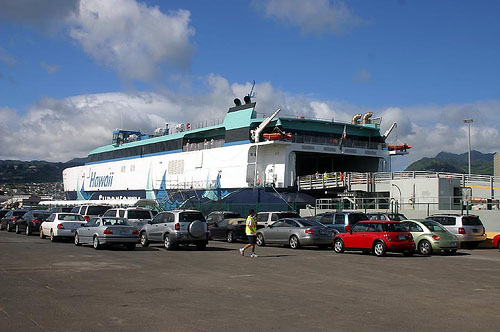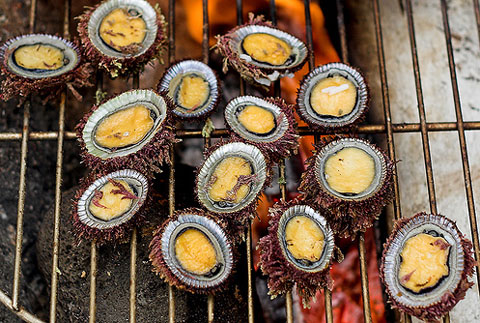www.islandbreath.org ID#0809-13
SUBJECT: HAWAII SUPERFERRY EIS
SOURCE: JONATHAN JAY jonathan@dakauai.com
POSTED: 20 MARCH 2008 - 9:00am HST
Yes. Kauai came to testify!

image above: KITV News films, while Honolulu Advertiser reporter takes note at afternoon session.
by Juan Wilson on 20 march 2008 About 40-60 attended the afternoon session of the Hawaii Superferry Environmental Impact Study hearing at KCC, in Puhi. Only four attended the afternoon session on Oahu, an island with over tens times the population as Kauai. That represents 100 times the participation. Kauai's two sessions broke the reocord of attendence on all islands at all sessions. The testimony went 100% against the operation of the Superferry. Many, including myself, questioned the appropriateness of Belt Collins as the consultant to do the EIS and even the afer the fact EIS process itself.
The following is backup material for my testimony. Bold Improvements to Be Completed by 2014 Act 2 EIS Statement from HSF EIS by Belt Collins 17 March 2007 http://www.malamakauai.org/docs/Superferry-EIS_03-17-08.pdf Purpose of the Environmental Impact Statement The purpose of this EIS is to evaluate the environmental consequences of the proposed action and its secondary impacts, including impacts of a large-capacity ferry vessel operator. Responsible opposing views on significant environmental issues will be identified so that the DOT may make a sound decision... Purpose of the Action The purpose of the DOT’s action is to provide harbor improvements within the DOT’s existing commercial harbors to support large-capacity ferry operations... Need DOT commercial harbor improvements are needed to allow large-capacity ferry vessels to operate within the state of Hawaii. The legislature, as documented in Act 2, Second Special Session of 2007, found that the operation of a large-capacity ferry vessel company, specifically one that uses a new class of large-capacity ferry vessels capable of transporting large numbers of people, motor vehicles, and cargo with ease, to be in the public interest because it provides a real and innovative alternative to existing modes of transporting people, motor vehicles, and cargo between the islands of the state.
Hawaii Superferry study to go to open bid Hayashida says he was unaware of ethics conflict Engineering firms sued in Kaloko dam failure http://the.honoluluadvertiser.com/article/2008/Mar/16/ln/hawaii803160348.html By Diana Leone on 16 March 2008 in The Honolulu Advertiser Two O'ahu engineering firms are being sued in connection with the March 14, 2006, failure of the Kaloko dam on Kaua'i. Belt Collins, which has an office in Honolulu as well as in other U.S. and foreign cities, and Hirata & Associates Inc., which is based in 'Aiea, are named as defendants in civil suits filed in Kaua'i's 5th District Court on Tuesday. The lawsuits say that the consulting firms, which were employed by Jimmy Pflueger for work on his Kaua'i property that includes Kaloko dam, "failed to take appropriate actions to correct a 1997 grading violation — including removal of material that covered the spillway, and/or notifying the county of the precise area filled in 1997, including the spillway." The suits say the consultants' actions were "negligent or grossly negligent."
|
SUBJECT: HAWAII SUPERFERRY EIS
SOURCE: JONATHAN JAY jonathan@dakauai.com
POSTED: 19 MARCH 2008 - 7:00am HST
Can I Get a Witness?

image above:om Mitrano of Belt Collins, the state's consultant for an EIS , gave instructions to people
at a meeting at Farrington High School on Ohau. Photo by Richard Walker
TESTIFY AGAINST THE ALAKAI, MARCH 19th!
|
SUBJECT: HAWAII SUPERFERRY EIS
SOURCE: JONATHAN JAY jonathan@dakauai.com
POSTED: 15 MARCH 2008 - 10:30am HST
Oahu Superferry EIS Meeting:
Kauai can do better than that.
by Jonathan Jay on 15 March 2008
|
SUBJECT: HAWAII SUPERFERRY EIS
SOURCE: JUAN WILSON juanwilson@mac.com
POSTED: 4 MARCH 2008 - 8:00am HST
Hawaii Superferry EIS finally begins

image above: Traffic lined up at Superferry from http://macprohawaii.blogspot.com/2007_11_01_archive.html
HI DOT HSF EIS Meetings on Kaua'i |
SUBJECT: SUPERFERRY DAMAGE
SOURCE: JUAN WILSON juanwilson@mac.com
POSTED: 12 FEBRUARY 2008 - 8:30am HST
Feared environmental plundering occured

image above: Hawaiian opihi on the grill. A delicacy today almost extinct on Ohau.
[Editor's Note: It was anticipated that a significant allure of the Superferry would be to allow illegal drive-on drive-off violations of natural resource plundering of the neighbor islands. The record for early operations of the Superferry bears out the fears many had. Remember, on the first day of Maui service three truck loads of imu pit river rocks were detained at Kahului Harbor, bound for Oahu. The article below identifies dozens of cases of violatiions including the discovery of buckets of opihi, tree limbs, sand etc, in vehilces bound for Oahu. Needless to say, the reports only account for those violators who were caught, and no citations were issued. With the ferry running at only a third of capacity, we can only expect worse to come.] Ferry screeners effective early on During Hawaii Superferry's first weeks of operation, passenger and vehicle screenings intercepted coolers of 'opihi and other marine resources, fishing nets, dozens of dead honeybees and an uncertified shipment of 50 orchid plants, according to an oversight task force report. No Charges in Maui River Rock Case
|
see also:
Island Breath: HSF dry docked 2/9/08
Island Breath: HSF Rudder Mess 2/5/08
Island Breath: January HSF News 1/24/08
Island Breath: HSF night trips 1/11/08
Island Breath: HSF military trips 1/8/08
Island Breath: HSF EIS Smoking Gun 1/6/08
Island Breath: HSF two trips 1/5/08